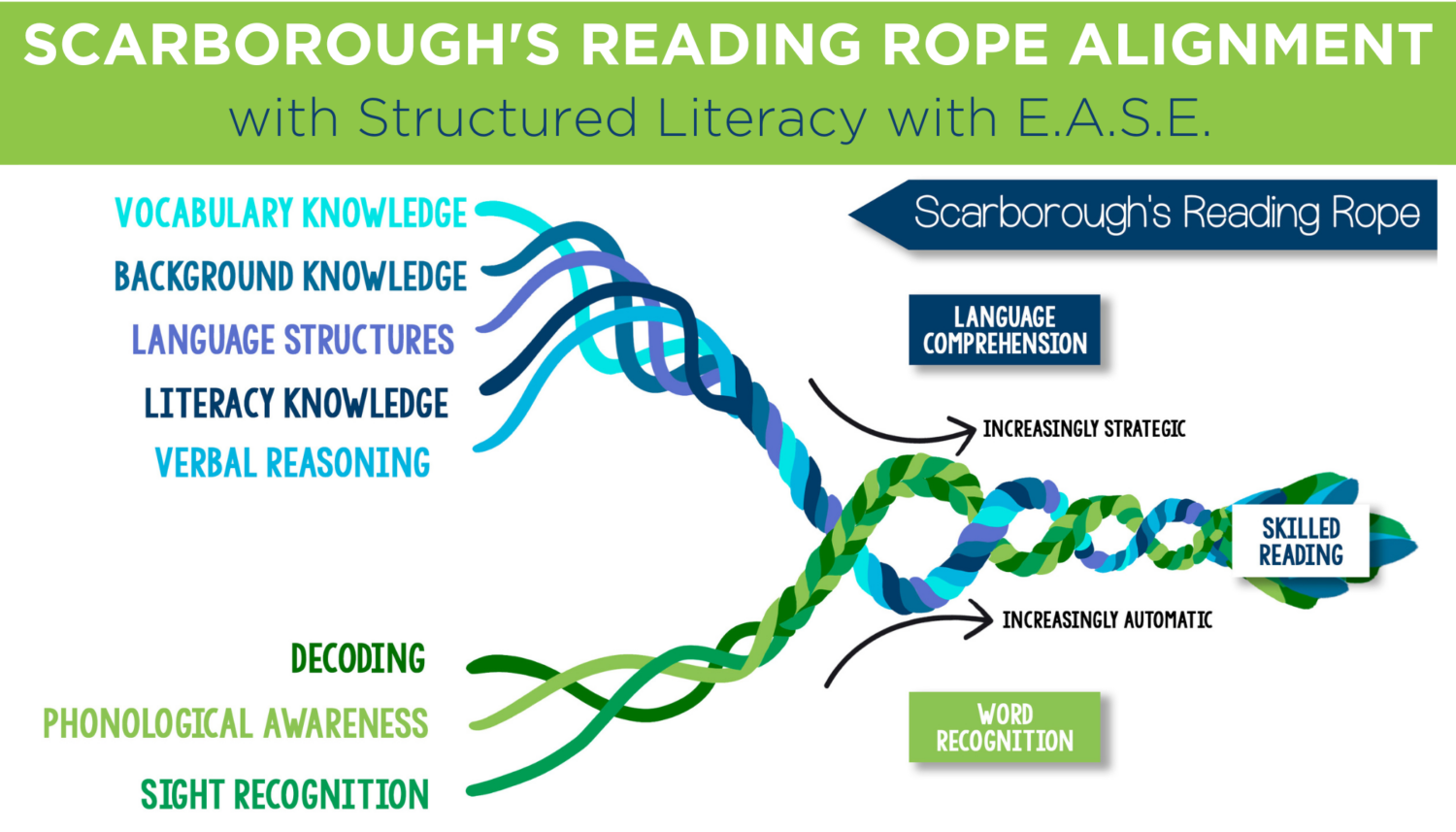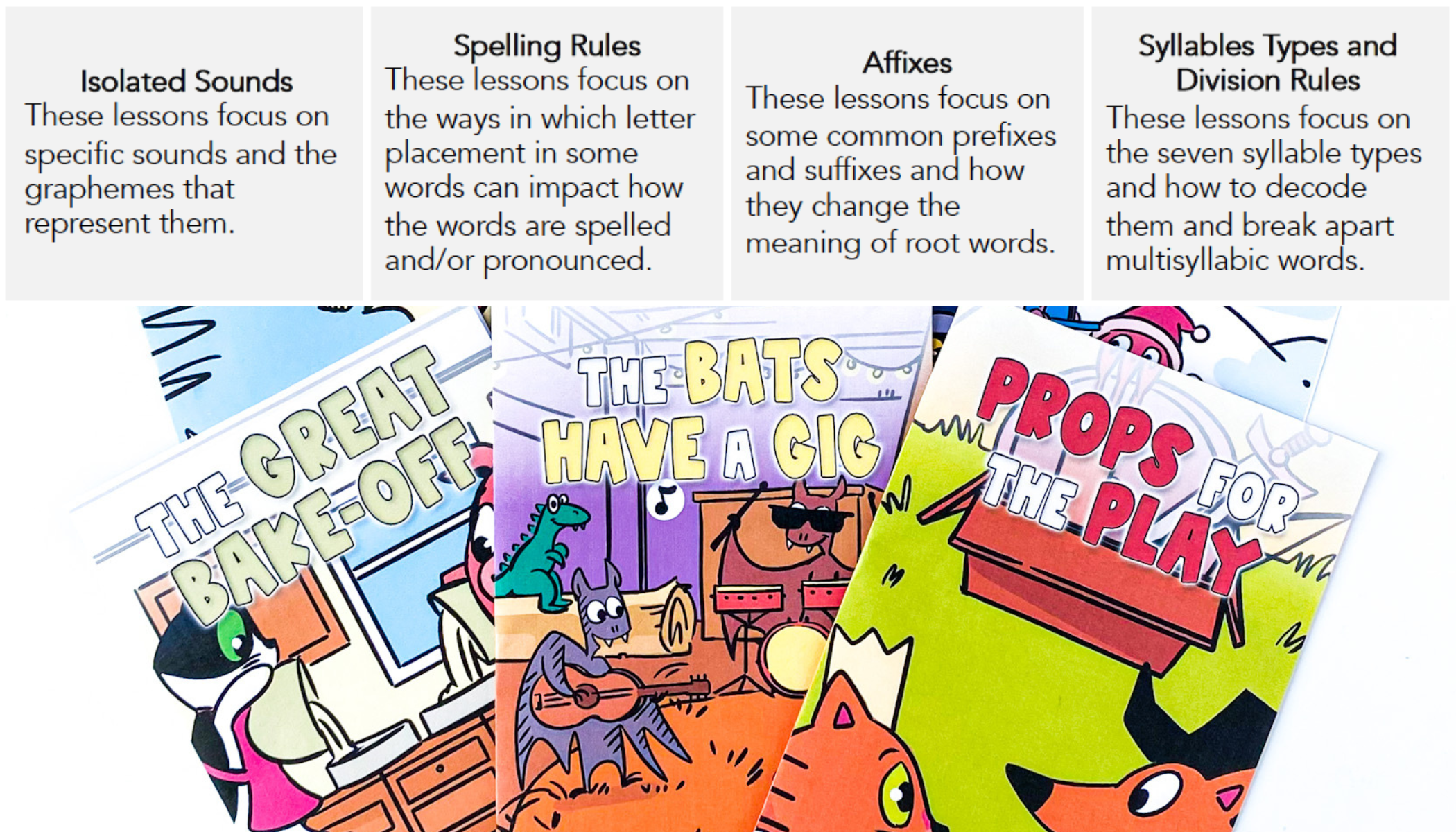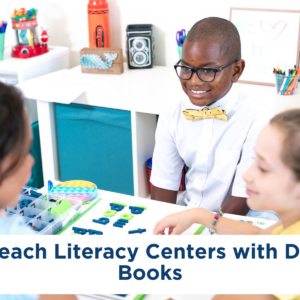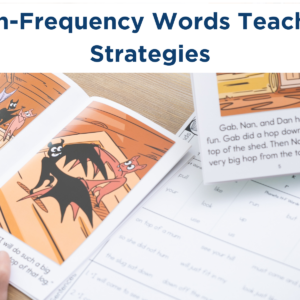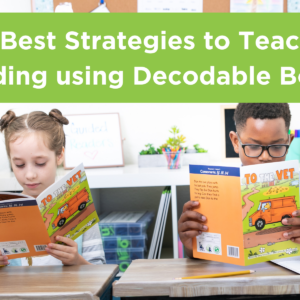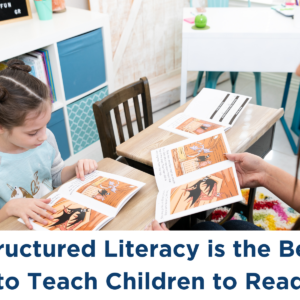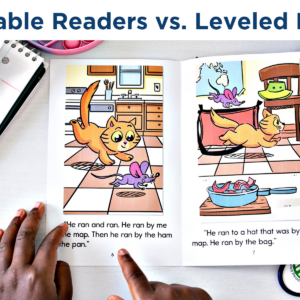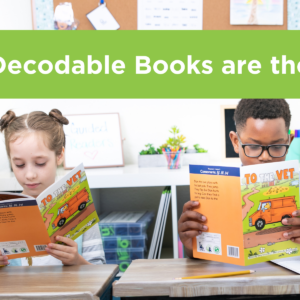Are you ready to transition your instruction and begin using a Structured Literacy framework based on the Science of Reading research? Then, you’re in the right place!
Structured Literacy with E.A.S.E. is a research-based program created based on the Science of Reading and the Simple View of Reading. This program addresses all strands of Scarborough’s Reading Rope.
Our program gives you the tools, lessons, and strategies to implement a solid Structured Literacy framework in your small-group instruction so you can successfully help students learn the code and how to read for meaning.
Below is an overview of how Scarborough’s Reading Rope is represented throughout the Structured Literacy with E.A.S.E. program.
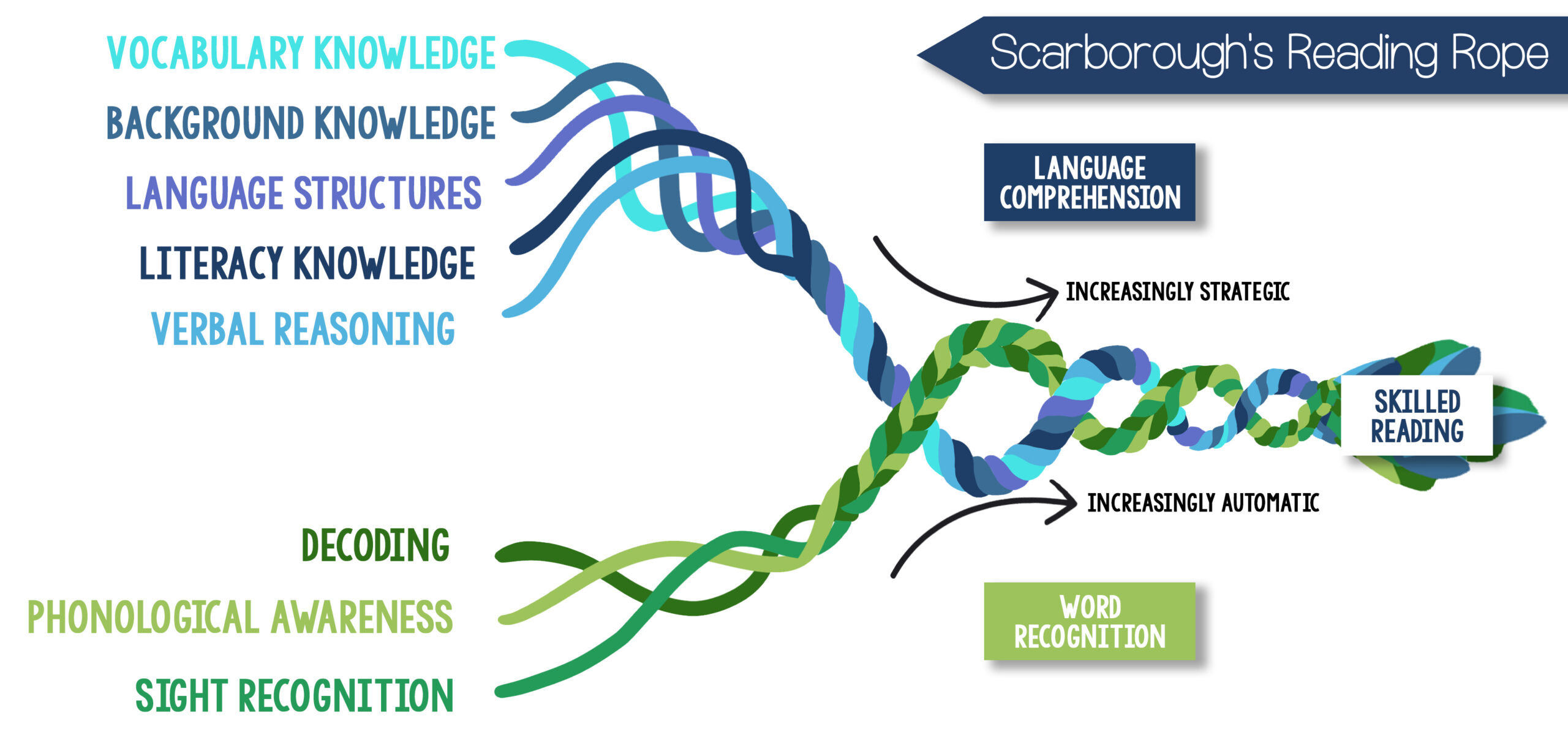
What is Scarborough’s Reading Rope?
Dr. Hollis Scarborough is a scientist focused on language and literacy. She explains how the components of reading are like strands within a rope. Each strand weaves together in the process of building skilled readers.
Scarborough’s Reading Rope infographic helps us see and understand the various skills children must master to become proficient readers. It contains two main sections:
- Word Recognition Skills including Decoding, Phonological Awareness, and Sight Recognition. These skills become increasingly automatic over time.
- Language Comprehension includes Vocabulary Knowledge, Background Knowledge, Language Structures, Literacy Knowledge, and Verbal Reasoning. These skills become increasingly strategic over time.
All of these skills are necessary for skilled reading to take place. The components are interconnected. So if one strand is weak, it affects the entire rope, just like in reading. Likewise, when one skill is weak in reading, it can affect the whole reader.
So below, you’ll see how each strand of the rope is demonstrated in the Structured Literacy with E.A.S.E. program.
Structured Literacy with EASE program overview
The Structured Literacy with E.A.S.E. program consists of six modules (or seven, including the supplemental sequence at the end.) We call these modules “sequences.”
The first two sequences are pre-reading sequences, which ensure students understand the basic letter sounds, basic consonants, and short vowel sounds. There is also a sequence to help students learn the most critical 109 high-frequency words that appear in texts.
When we get into Sequence 1, students can begin applying their skills in reading. Most every lesson in Sequences 1-4 comes with a decodable text. The skills start in Sequence 1 with basic CVC skills and then move through the other syllable types, phonic skills, and spelling patterns, all the way to Sequence 4. At that point, students are proficient readers.
Now, let’s move into how each strand of Scarborough’s Reading Rope is included throughout the program.
Phonological Awareness
Phonological Awareness is about understanding that words are made from different sounds. Kids learn to speak without needing to see a written word. But when they learn to read, they need to recognize that sounds correspond with the words they see on the page. This is a very early skill and sets the stage for what follows.
In the Structured Literacy with EASE program, the lessons include a daily 5-minute warm-up across 12 different phonological awareness activities:
- Onset and Rhyme
- Rhyme Recognition
- Rhyme Production
- Initial Phoneme Isolation
- Initial Phoneme Deletion
- Alliteration
- Phoneme Segmentation
- Phoneme Blending
- Phoneme Substitution
- Final Phoneme Isolation
- Final Phoneme Deletion
- Sentence Segmentation
The skills they practice during the warm-ups become increasingly automatic. Therefore, these warm-ups are emphasized early in the program and phase out in Sequence 3 because the skills are more automatic and folded into students’ decoding and encoding practices.
Decoding
Decoding is at the heart of the Structured Literacy with E.A.S.E. program. It is when students sound out words grapheme by grapheme. The sound sequence begins with teaching individual alphabet letters, basic consonants, and short vowel sounds.
We have 26 lessons, so there is one for each alphabet letter. There is also some basic letter formation and identifying where you hear the sound in a word (beginning, middle, or end) and where you see it in the word. At this point, students are beginning to make the connection from sound to print. They begin to understand that alphabetical symbols represent sounds.
The program also includes Sound Spelling beginning with basic alphabet sounds and moving into sounds represented in multiple ways. Early on, students use the Spell-A-Sound worksheet to say the sound while writing the matching letter.
Then when they move into more complicated sounds, like long-vowel sounds, they can write them in multiple ways. At this point, they start to use a notebook to list all the different ways they can spell that sound. Doing this helps them to increase that knowledge.
The program also uses nonsense words to warm-up reading activities to ensure students are really using decoding skills without relying on context clues. This becomes increasingly automatic as students move from identifying letters and their basic sounds to applying them to words, sentences, and entire decodable texts.
The program has four skill categories for decoding:
- Isolated Sounds
- Spelling Rules
- Affixes
- Syllable Types and Division Rules
Isolated Sounds
Decoding isolated sounds is an integral part of the entire program. When we introduce students to a new sound, we give them a graphic they can use to do multi-sensory exercises to reinforce the phoneme that goes with the grapheme.
We also have basic sound posters representing the basic consonant and short vowel sounds. Then, later in the program, there are sound posters for all the most common ways to make the sound.
This is where word mapping becomes really important. So students are given mapping mats they can use as they map words. They can also use a whiteboard, especially when mapping multi-syllabic words with more than five sounds. The program also has word-chaining activities where students build a word and change out one sound to create a new word.
You’ll see these activities throughout all of the isolated sound lessons.
Spelling Rules & Affixes
Spelling Rules and Affixes lessons follow a very similar format. It’s important to mention these skills are explicitly taught. We explain the spelling rules in a way kids can understand.
Affix lessons explain the meaning of a prefix or suffix and how it changes the base word. Students also learn to break the words apart and write out their meanings. So it’s part spelling and also part vocabulary lesson.
Syllable Types and Division Rules
We also have lessons related to syllable types and division rules. Students learn the seven syllable types and how to break apart words.
We have resources to help them learn the syllable types, including posters that walk them through the rules and mats specifically for mapping words for the specific syllable types. Students also learn a particular way to map out how many vowels sounds they hear and then fill in the sounds for the syllable types.
Other activities students engage in include syllable sorts, where they look at real words from their text to see if they can sort them into categories based on their syllable type.
Site Recognition
It’s important to understand why we need site recognition. There are some words used so frequently that we recognize them on-site. The ability to do this contributes to more fluent reading. Structured Literacy with E.A.S.E. recognizes that most high-frequency words are decodable. Even words considered irregular are mappable.
When decoding words with irregular graphemes, readers use their extensive sound and word knowledge repertoire to work through similar words. Structured Literacy with E.A.S.E. explicitly and systematically teaches 358 high-frequency words called the E.A.S.E. Word List.
In cases where the high-frequency word goes along with a phonic skill, it’s taught alongside other skill words. In other cases, we introduce high-frequency words as “Heart Words” or “wise words.”
Heart Words are irregular high-frequency words that break the predictable spelling or pattern the students are learning. Wise Words are decodable words that students don’t yet have the skills to decode. We introduce these words because students are likely to come across them in stories before they learn the skill to decode them.
At the start of each decodable book, there is a list of the included Heart Words, high-frequency phonetic words, and preview words.
The high-frequency phonetic words are words from the E.A.S.E. Word List that students can sound out using their current skill set. The Preview Words are words using a skill students will soon learn. There are very few preview words in our decodable books. Some don’t have any, and others may have three at the most.
109 High-Frequency Words
In Structured Literacy with E.A.S.E., we dedicate an entire sequence to learning the 109 most used high-frequency words. Students do all kinds of activities with the words.
For example, students map the words, even irregular heart words. We also give them chances to identify the word in various typefaces so they see the different ways they may encounter the words.
An emphasis is placed on learning high-frequency words from the beginning of the program. And we continue to introduce them throughout the rest of the program explicitly. These words become increasingly automatic, and by Sequence 4, we’ve introduced all 358 high-frequency words from the list. Students spiral through and continue to use them in their reading throughout the program.
Background Knowledge
Now we’re moving into the language comprehension part of Scarborough’s Reading Rope.
Background knowledge strengthens a learner’s comprehension of the text by allowing them to use prior knowledge to understand new things. This skill helps students develop a deeper understanding of stories and texts.
The Structured Literacy with E.A.S.E. program draws on background knowledge in various ways. First, every book includes a reading comprehension activity requiring students to synthesize information. They must infer and draw conclusions to relate their existing knowledge to new knowledge.
Additionally, the stories are written to connect characters, storylines, and ideas across the series. So students must rely on background knowledge to understand character traits and how or why they act the way they do in certain situations. These skills become increasingly strategic as the program progresses with increasingly complex tasks.
Early on, students are directed to their connections and conclusions; later in the program, they create their own. For example, in a Sequence 2 lesson, the worksheet walks them through making connections. They connect to another story, an experience they’ve had, or something they’ve seen in the news. Then in Sequence 3, students directly choose from the text the connections they have to what is happening.
There are also opportunities for students to use their knowledge to identify X Y or Z related to a reading skill or to draw conclusions directly. Students constantly use comprehension skills, strategy, inferring questions, and vocabulary.
Vocabulary
Vocabulary refers to the quantity and quality of a student’s known words. Unfortunately, getting new vocabulary words in a decodable text can be tricky, mainly because words are so controlled in these books. So Structured Literacy with E.A.S.E. introduces one phonetic word per book and one other vocabulary word that’s not written in the text but captures an important aspect of the plot, characters, or theme.
In early sequences, students define or illustrate the terms, and the teacher provides additional support to explain the meaning. But in later sequences, students find a word on their own to define and explore.
It’s increasingly strategic as more new and interesting vocabulary is introduced in these texts. So again, we’re teaching a new decodable word based on the skill of the book and another word that isn’t even in the book but gives a chance to capture a theme or idea from the text.
Language Structures
Language structures refer to the semantics and syntax of the language used. It’s important to realize that this is not only related to the language used when kids read but also includes the words they use when they write. Both are represented in Structured Literacy with E.A.S.E.
The decodable books in the series build in complexity across all sequences and within one week of the lesson. In a typical four-day lesson in Sequence 1, students first warm up to the sounds, words, phrases, and sentences before reading the book. This gets them ready for the real application of their skills.
You can also see the progression of text complexity from an early book to the last book of the sequence. The language structure becomes more complex. The books have longer sentences, more figurative language, and new words. Dialogue is used to show the cadence of speech and how it’s represented in texts.
Lastly, students have dictation activities in every lesson to help reinforce language structures in their encoding efforts. Any time a lesson or book lends itself to figurative language or talks about literal and non-literal meanings of words and phrases, it’s shown in the reading comprehension aspect of the lesson.
Verbal Reasoning
Verbal reasoning has to do with a reader’s ability to think about the text and infer meaning from what is explicitly and implicitly stated. So readers must make logical inferences. They must integrate ideas within the text and interpret abstract language. Therefore, figurative language is included in every sequence to reinforce the idea that phrases have literal and non-literal meanings.
Reading comprehension activities also require students to infer, synthesize, and apply ideas, so these become increasingly strategic. You might see in the beginning that we are leading students to a major theme, and at the end, they have to synthesize and derive that themselves.
Another lesson discusses the purpose of advertisements in the book and the author’s purpose.
Literacy Knowledge
Literacy Knowledge is the understanding of a text’s purposes, features, and conventions. Structured Literacy with E.A.S.E. puts real books in the hands of even the youngest learners, so they become accustomed to simple print concepts, holding a book, turning the pages, reading left to right, and things like that.
Students practice in scaffolded work pages before they apply their knowledge to complete books. So they’re going through and getting the scaffolding of print concepts, but then they get to go and practice right away with real books.
We stick with fiction stories throughout the program. With such controlled vocabulary in decodable books, we couldn’t do justice to non-fiction readers and all the domain-specific words required.
So we begin with fantasy, where the animals talk and wear clothes, and then transition the world into including humans in Sequence 3. By the end of the series, we end with realistic fiction so that we can introduce fiction in various ways.
Students are asked to reflect on the genres and things like the author’s purpose within the series through the use of the reading activities. For example, we may ask questions like “What are clues this book is fiction?”
Later in the program, students separate things that could happen in real life from things that can’t. Then, they continue to derive information about the genre of the story as the program progresses.
So even though there aren’t a variety of genres represented due to the controlled vocabulary, there is an opportunity to discuss the fiction genre within the program.
An Easy Overview for Structured Literacy with E.A.S.E.
Structured Literacy with E.A.S.E. also has an excellent tool showing all of the different types of activities, their sequences, and how it’s incorporated. This resource makes it easy to see a recap of what the program offers and how it includes all strands of Scarborough’s Reading Rope.
You can download a FREE sample lesson from the program or learn more through the Program Information and Explicit Scope & Sequence here.

